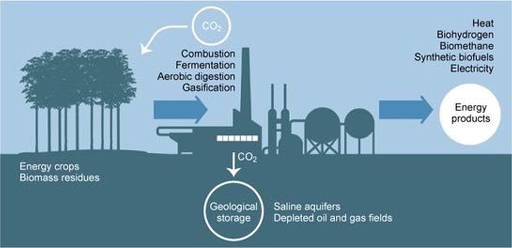4 Increasing energy out
Geoengineering methods that increase outgoing energy from the Earth include carbon dioxide removal (CDR). These methods reduce the greenhouse effect by decreasing atmospheric carbon dioxide concentrations (note, not emissions). You will look at two key CDR methods.
Unlike SRM methods, CDR methods are not instantaneous in taking effect: there is a limit to how quickly a difference can be made to global CO2 concentrations.
Once you have extracted CO2, you need to put it somewhere. So there are two parts to CDR:
- extraction: capturing CO2 from the atmosphere, and
- sequestration: storing the CO2 or carbon so that it does not re-enter the atmosphere.
Planting trees is not enough to extract CO2 from the atmosphere for the long term. When the trees respire, burn or decompose they return carbon to the atmosphere.
Bioenergy with carbon capture and storage (BECCS) extracts CO2 as a natural process,but then goes one step further in that itcreates energy as a by-product of CO2 removal.
In BECCS, biomass such as wood, sugar cane or switchgrass is used for energy, and the emitted CO2 is captured and stored. Carbon capture and storage (CCS) itself is not unique to bioenergy power stations – it can also be used to reduce carbon emissions from fossil fuel power stations. But using it with bioenergy breaks the closed loop system and removes carbon from the system into long-term storage.
The carbon sequestration is usually proposed to be in geological reservoirs – in the porous spaces of rocks, including those left behind when oil and gas are extracted.
Listen to the discussion of CCS and BECCS in the audio, which is an extract from the BBC’s ‘Changing Climate: The Solutions’ broadcast, presented by Roger Harrabin (November 2015). Then study the diagram of a BECCS plant in Figure 10 and answer the questions that follow.
Transcript: Audio 1 Extract from the BBC’s ‘Changing Climate: The Solutions’, presented by Roger Harrabin (November 2015).
-
Is BECCS a technology that produces positive carbon emissions, zero emissions, or negative emissions, and why?
-
It is a negative emissions technology, because it ‘takes CO2 out of the atmosphere’. In other words, overall, BECCS extracts (and sequesters or stores) more CO2 from the atmosphere than it emits from the energy use.
-
The presenter in the audio describes one stage of BECCS as ‘then you burn the plants’. Looking at Figure 10, what other ways are there to extract carbon from plants?
-
As well as combustion, Figure 10 also shows fermentation, aerobic digestion and gasification.
In principle, BECCS could be both achievable in the near term and effective over the long term. Lenton and Vaughan (2009) estimate that BECCS could offset two-thirds of a doubling of atmospheric CO2 concentrations by the end of the century, while the assessment of McGlashan et al. (2012) is that the technologies ‘could be introduced relatively easily in today’s energy system’ and reduce current UK CO2 emissions by at least 10% by 2030.

